Table of Contents
Twitch stands out as the top platform for live streaming online.
Data indicates that approximately 9.6 million unique creators broadcast on Twitch each month. Successors aiming to compete with it have tried, with YouTube—known for its video hosting features—attempting to attract top gamers, but none have managed to surpass Twitch.
Many people assume that streaming on Twitch requires playing video games, but this is a misconception. You don’t need to focus solely on gaming; the platform welcomes a variety of content, from cooking shows and artistic pursuits to audio production and music. It serves as a dynamic space to share knowledge, foster community connections, and even earn money. You also don’t have to be a seasoned professional or own high-end gaming equipment. Streaming can be hassle-free with just your mobile device, Mac, or PC coupled with streaming software. This comprehensive guide will walk you through the detailed steps to start streaming on Twitch in 2021.
Overview
Twitch.tv is a platform dedicated to live video streaming, where users can share and view content across various genres including gaming, arts and crafts, music, fitness, martial arts, and much more. Creators from around the world gather here to build communities, exchange ideas, and collaborate on creative projects. Since its launch, Twitch has grown significantly: founded by Justin Kan in 2011, it attracted 45 million unique visitors by 2013. Recognizing its potential, Amazon acquired the platform in 2014, and its user base continued to expand—reaching 55 million in 2015 and 140 million monthly users in 2020. Today, it ranks among the largest streaming services globally, with iconic streamers like Dr. DisRespect and Shroud rising to fame on its platform. Interestingly, movies have also capitalized on Twitch’s popularity—for example, Avengers: Infinity War generated extensive Twitch engagement weeks after its debut.
Why Stream on Twitch?
Here are some reasons why Twitch is a great choice for streamers:
- The platform’s user interface is optimized for live streaming, offering seamless integration with Live: Air Solo, making setup straightforward.
- Recent updates include a built-in Twitch chat feature within Live: Air, allowing creators to engage with viewers in real-time during broadcasts.
- The software automatically categorizes streams, helping users connect with specific audiences interested in their content.
Getting Started With Twitch
Before you begin streaming, you’ll need to set up your account and adjust some settings. Here’s a step-by-step guide to help you start streaming on Twitch:
1. Create Your Account
Registering on Twitch is simple, but it’s important to review the Terms and Conditions and Community Guidelines beforehand. Familiarizing yourself with the rules helps you use the platform responsibly. Violating guidelines might lead to a ban, and there’s no guaranteed way to reverse it—your account could become inactive, requiring a fresh start with new credentials and IP address.
To sign up via desktop, navigate to the official Twitch website. On the homepage, click “Sign Up” and complete the form with your details. You will be prompted to enter a username, password, email address, and your date of birth. You can also select a display name that doesn’t necessarily reflect your real name, allowing for more privacy and personalization.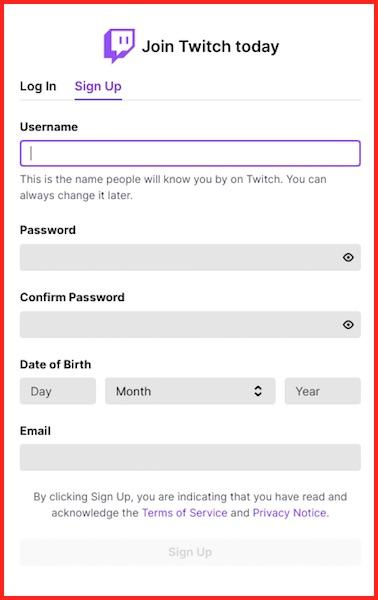
To sign up via mobile, download and install the Twitch app on your device, then open it. Tap the Sign-Up button. You can choose to register using either your phone number or email address. Twitch recommends registering with your phone number first, then adding and verifying your email for added security.
Verifying your email provides several benefits:
- You will receive email notifications.
- If you lose access to your mobile number, your email verification will still keep your account secure.
- You can participate in chats that require email confirmation.
If you’d rather sign up with an email instead, select the “Use email instead” option. After entering your details, click the Sign-Up button. A six-digit code (OTP) will be sent to you via SMS or email to verify your contact information.
Once your email is verified, you can create additional accounts by enabling the relevant option in your security settings section on your dashboard.

2. Enable Two-Factor Authentication.
Twitch requires two-factor authentication (2FA) to help secure your account against unauthorized access. You cannot stream until you enable 2FA. Remember, your email must be verified before you can set up 2FA. Once verified, visit your Security and Privacy page from desktop. Click on “Set Up Two-Factor Authentication” and select the “Enable 2FA” option.
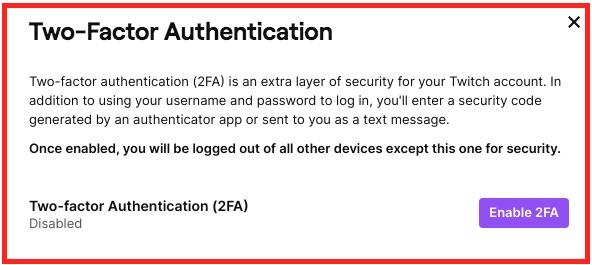
Next, input your phone number and click Continue to proceed. You will receive a 7-digit verification code via text message, which you should enter to confirm your number.
If you are using an authentication app, scan the QR code displayed with your phone’s camera. Alternatively, you can skip this step and choose SMS verification instead. To scan the QR code, download an authenticator app from your phone’s app store.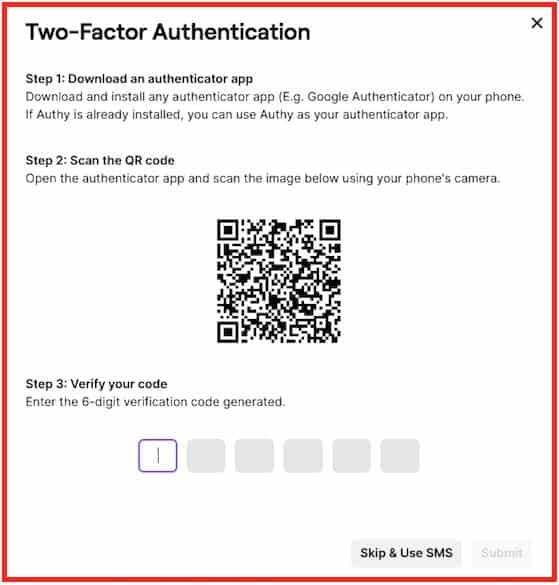
To activate Two-Factor Authentication (2FA), scan the provided QR code, enter the six-digit code generated in your authentication app, and click “Submit.” Once completed, your account will be protected with this extra security layer.
Headings
3. Selecting the Right Streaming Software for Twitch Live Streaming
Software is crucial when streaming from your PC as it enables you to connect your webcam, stream gameplay, broadcast live, and interact with viewers. Popular options include:
– Twitch Studio
– OBS Project
– Streamlabs OBS
– XSplit
– Vmix
– Elgato Game Capture
– Live Gamer Extreme
– Lightstream
Twitch recommends these platforms for beginners and first-time streamers. Many of these encoders are available free or as paid versions. When choosing live streaming software, consider these key features:
– Compatibility with multiple platforms such as Twitch, YouTube Live, Facebook Live, LinkedIn, Twitter, and others.
– Customization options and how well they meet your needs.
– Support for high-performance integrations with third-party apps and plugins.
– Availability of customer support for troubleshooting.
– Ease of setup and user-friendly interfaces that simplify the process of adding channels.
Your choice will depend on your specific requirements, but popular options like OBS Project, Streamlabs OBS, and XSplit are solid starting points.
Briefly, XSplit offers ease of use and features smooth setup with support for many streaming platforms but is only available on Windows. OBS Project is open-source, compatible with Windows, macOS 10.13+, and Linux, though initial setup may take more time. For new streamers, Twitch’s own software, Twitch Studio, comes with a guided setup, customizable templates, and a user-friendly interface, making it ideal for beginners.
4. Choosing Appropriate Hardware for Live Streaming
Having dependable hardware is essential for a smooth streaming experience on Twitch. While you don’t need top-of-the-line equipment, your hardware should be capable of handling the demands of live streaming without issues.
Here are some hardware recommendations:
Computer
Use a computer with sufficient performance to support streaming, especially if you intend to play demanding PC games. It should be capable of encoding your video and audio efficiently for transmission to Twitch.
Laptops
Opt for a reliable laptop if you plan to stream while traveling or in busy locations. Although more expensive than standard models, they’re valuable for mobility. Recommended models include the ASUS TUF Gaming Laptop (15.6”) for basic needs and the ASUS ROG Strix Scar II (15.6”) for mid-range performance. MacBooks are also popular among creative users, especially musicians, with the MacBook Pro 13” featuring an 8th Gen i5 processor and 128GB storage being a common choice. Remember, you’ll need a USB C Hub with Ethernet, HDMI, and USB 3.0 ports for optimal connectivity.
USB Interfaces and Mixers
To connect your audio equipment with your streaming PC, use an interface or mixer with a USB output. Well-known options include Yamaha AG03, Focusrite Scarlett 2i2, Yamaha MG10XU, Mackie ProFXv2, and Steinberg UR44.
Microphones
Microphone quality is critical for clear audio during streams. Choose a microphone suited to your environment and budget, ensuring your audience hears you without background noise or distortion.This setup requires a microphone capable of capturing your voice clearly so your audience can hear you distinctly. The microphone needs to be audible enough for viewers to understand every word you say.
Popular models for streaming microphones include:
– Blue Yeti (a basic condenser microphone)
– Audio-Technica AT2020 (a mid-range condenser microphone)
The Audio-Technica AT2020 has been considered a standard for streamers since its release in 2004. It’s appreciated for its excellent sound quality and its foldable design, which makes it easy to carry around. The Blue Yeti is favored because of its large-diaphragm condenser design and multiple pickup patterns, allowing flexible positioning while remaining quiet enough to record every breath clearly when placed in front of you. Additionally, entry-level options like the Blue Snowball are also effective for beginners.
For cameras and webcams, you can use your laptop’s built-in camera or connect a dedicated camera via a capture card. If you prefer simplicity, straightforward webcams suffice without complicated setups. Some well-known options are Logitech C920, Razer Kiyo, and Logitech Brio.
Lighting plays a crucial role in producing high-quality streams. It’s important to have bright, evenly distributed lighting that illuminates your face and gameplay clearly. If your room is poorly lit, digital cameras won’t deliver optimal results. Instead, utilize natural light or supplementary lighting such as white lamps with reflectors, plexiglass panels replacing windows, or softboxes with LEDs to create a warm, inviting glow.
Streaming from a computer often requires mounting your camera on a tripod for stability. Suitable mounts include desk-mounted options like the RODE PSA 1 or short weighted stands like the Gator Frameworks stand. To diversify backgrounds, consider using a green screen, allowing you to project various images or settings behind you. In addition, you’ll need essentials such as a headset, a reliable internet connection, dual monitors, and a good graphics card, such as Nvidia’s 1660 Ti.
Before going live, it’s vital to customize and configure your channel to attract viewers. Set up key elements like your stream’s title, category, and notifications through your dashboard’s settings. Personalize your profile with a profile picture and bio, which can be edited easily from your mobile device or desktop. Enhance your channel with an attractive banner and informative panels that explain your content and include external links to guide viewers outside Twitch. Keep panel sizes around 320 by 160 pixels for a professional look.
Some recommended tools for creating your Twitch panels include Nerd or Die, which offers a variety of free templates that can be customized in colors, icons, fonts, and sizes (note: installation may be required). Snappa is another option, providing access to over 4 million templates for designing banners, thumbnails, and other digital art.
Once your setup is complete, you’re ready to start streaming. You can broadcast directly from your Mac, PC, smartphone, or through a web browser. To stream from a desktop, download streaming software such as Twitch Studio, XSplit, or OBS Studio (Open Broadcaster Software). I’ll demonstrate using OBS Studio, which is available at OBSproject.com.
After installing OBS, follow the setup instructions to connect your microphone, camera, and scene configurations for a smooth streaming experience.When installing OBS, your initial task is to obtain your “Stream Key” from your Twitch account. This is a unique identifier that you will need to input into OBS to connect it to your Twitch channel. You can easily locate the Stream Key under the “Settings > Stream” section within your Creator Dashboard. Make sure to copy this key carefully so you can paste it into OBS later.
Please note: your Stream Key is confidential. Do not share it with anyone, as anyone with access to your key can broadcast on your channel without permission. Keep it secure.
After copying your Stream Key, return to OBS. Navigate to the “Settings” menu, then select “Stream.” From the dropdown menu, choose Twitch, and then paste your Stream Key into the designated field. Once you’ve done this, OBS will be set up to broadcast your streams to Twitch.
Before you start streaming, you’ll need to configure some settings in OBS. One important setting is the video bitrate, which affects your stream’s quality. A higher bitrate results in better quality but requires a stronger upstream internet connection. You can refer to a specific chart to find the optimal encoding, bitrate, resolution, and framerate settings that balance quality and stability.
Next, in the Video Tab, input both your base resolution (the resolution at which you’re capturing your stream) and your output resolution (the resolution that viewers will see). Properly setting these parameters ensures your stream looks good while maintaining smooth performance.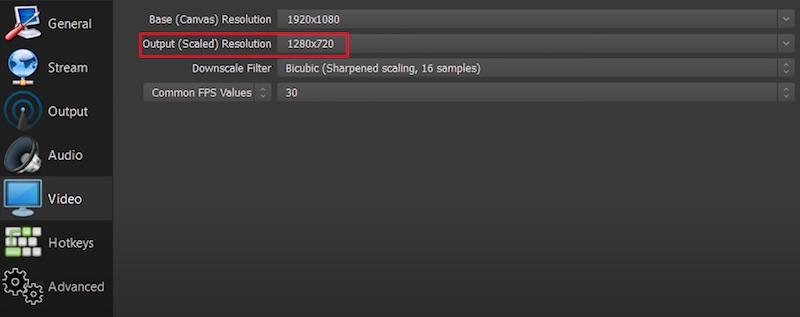

Next, go to the Audio tab, just above the Video tab. Here, set your Sample Rate to 48kHz and select the speakers and microphone you wish to use. This ensures your audio settings are optimized for streaming. After adjusting these, it’s important to configure the scene your viewers will see.
You need to set up three key components: your webcam, the game or show you’re streaming, and your microphone’s audio input. To do this, click the “+” icon in your main OBS window, which will allow you to add a new source. This is the part of your stream that shows up on your screen. You’ll be presented with options such as Display Capture (to record your entire screen), Game Capture (to record a specific game in full screen), and Window Capture (to record a particular application). Choose the suitable option and click OK to add it. For example, if you’re streaming a game, open that game, then select Game Capture. You can then resize or reposition the game window within OBS so it fits well in the scene.
To add your webcam, go back to the “Sources” list, select “Video Input Capture,” and specify the webcam device you want to use. This will display your camera feed in the streaming layout. Once everything is set, you’re ready to start streaming. Before going live, it’s a good idea to test your microphone, check your audio levels, and make sure all settings are correctly configured. Adjust the volume sliders in the “Mixers” section to balance your audio. You may also want to record a short test stream to confirm everything looks and sounds right.
These are the core OBS setup steps. For more detailed instructions, you can refer to an in-depth guide on streaming on Twitch with OBS. Alternatively, Twitch Studio offers a quick and user-friendly way to set up your stream, complete with tutorials on connecting your webcam and audio devices. Streamlabs OBS is another popular option, allowing you to link your Twitch account and providing its own guided setup process.
If you prefer mobile streaming, you can use the Twitch app available for iOS and Android. Download the app, log into your account, tap your profile icon in the top-left corner, and then hit the “Go Live!” button to start your broadcast.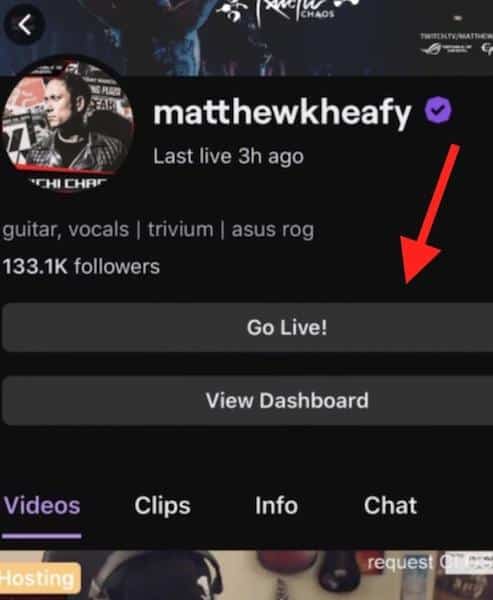

This method is the fastest way to go live on Twitch, and you won’t need specialized hardware or software. Your phone’s camera and microphone are enough to start streaming.
Alternatively, you can improve your audio quality during live streams by using apps like Dolby On for iOS or Android. Dolby On is a free app based in the US that offers Dolby’s advanced audio technology to enhance sound clarity and reduce noise.
To start streaming, log into your Twitch account and connect it with the Dolby On app. Once connected, simply click the Go Live button to begin. The integration provides superior audio quality, noise suppression, and dynamic equalization. Keep your phone or computer nearby to engage with viewers and respond to chat messages as they come in.
You can also stream directly from your web browser with no additional software by using Lightstream Studio. This platform allows easy guest invitations and stream setup with just a few clicks. Visit the Lightstream website, log into your Twitch account, and authorize access.
Follow the step-by-step instructions to connect your camera and microphone, ensuring you select “disable processing for music sources” for better sound quality. When ready, click the “GO LIVE” button located at the top right corner to start broadcasting. You can also stream gameplay from your current-generation Xbox or PlayStation 4 consoles.
Whether you are just starting out or are a seasoned streamer, there is always room for growth. Improving your channel’s reach involves sustained effort in refining your content, promoting your streams, and listening to your audience. Below are some strategies to increase your viewers and establish a stronger presence.
One effective approach is leveraging advertising and charitable initiatives. With millions of active users daily, Twitch offers a prime platform for targeted advertising. Many viewers support causes they care about and are receptive to ads supporting their favorite broadcasters. Twitch is primarily a marketing platform where 62% of viewers engage regularly with esports and gaming personalities, 70% support donations financially, and 64% follow product recommendations made by streamers. This allows you to tailor ads to specific niches and deliver targeted messages to your audience.
Engaging in charity work on Twitch can also boost your visibility and reputation. Successful streamers have raised millions for various causes, creating a positive association with their brand. For example, Fortnite streamer Ninja raised $2.7 million for St. Jude Children’s Hospital in July 2018, demonstrating how impactful charitable streams can be. These initiatives not only help good causes but also foster a loyal community around your channel.
He took part in various challenges, such as dyeing his hair or getting a tattoo, and his viewers continued donating during the live stream to support these efforts, helping him raise significant funds.
2. Collaborate with Brands.
Brands have the opportunity to promote themselves by teaming up with trusted streamers on Twitch. When you gather a dedicated following, you can reach out or be approached by brands interested in showcasing their products through your streams. This can involve including the brand’s name or product in your stream title or channel header, or naturally mentioning it during relevant moments. For instance, Totino’s Pizza once partnered with Twitch streamers who promoted eating pizza rolls after each game victory. Partnering with well-known brands boosts your credibility and helps establish your authority within the streaming community. Additionally, brands monitor how their promotions impact traffic, especially during scheduled streams. Typically, companies contact influencers either directly or through their management teams to set up partnerships.
3. Study Leading Streamers in Your Niche and Replicate Their Success.
Standing out on Twitch can be tough with so many creators using similar setups and competing for attention. You don’t necessarily need to reinvent the wheel—by observing top influencers in your area, you can understand what makes them popular. Use Twitch’s API to identify the top 10% of streamers based on metrics like viewer counts and follower numbers. Keep in mind that peak streaming times vary by location, so analyze data accordingly to find the best hours to stream. This insight also reveals popular games and trending content on the platform. With this information, you can adapt your approach and implement strategies that have proven successful for industry leaders, increasing your chances of growing your audience.
4. Utilize the Right Tools and Plugins to Grow Your Community.
Enhance your Twitch channel with various tools designed to boost engagement, manage donations, and streamline your streaming process.
Sound Alerts: Engage Your Audience.
Twitch’s built-in Sound Alerts allow viewers to trigger sound effects during your stream, encouraging active participation. You can upload custom sounds, and the system tracks donations through “Bit amounts,” letting you thank supporters in a personal way. This fosters viewer loyalty and creates a lively, interactive environment that can lead to positive word-of-mouth promotion. The feature also supports overlay alerts and chat notifications to maximize visibility.
Moobot: Automate Your Channel Management.
Moobot is a versatile bot that automates many routine tasks on Twitch, making channel management easier. It can share your social media links, post sponsor messages, handle song requests, conduct polls, run giveaways, and display important messages repeatedly. For example, you can program Moobot to respond to specific commands like, “Tell viewers about upcoming events,” enhancing engagement without constant manual effort. This automation helps build a loyal community by supporting constant interaction and making your channel operation smoother.
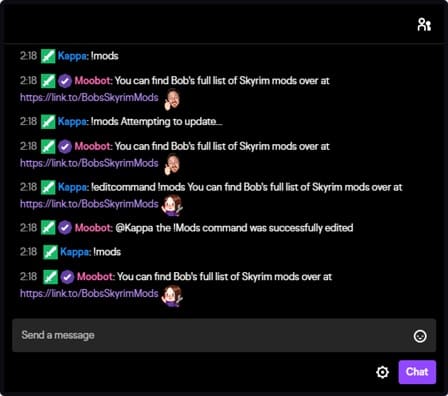
Another valuable tool is SullyGnome, which provides detailed statistics and analytics about streaming trends. It tracks data on popular channels, trending games, and growth rates, giving you insights to refine your strategy. For monetization, TipeeeStream allows you to accept donations via PayPal, credit cards, and cryptocurrencies, with customizable donation alerts to encourage contributions. Additionally, TeeBoard is a handy plugin for desktop streamers, enabling you to manage your channel, update statuses, and monitor activity smoothly during live sessions. These tools facilitate better community management and help you make informed decisions to grow your Twitch presence efficiently.Your stream’s features include broadcasting, highlights, running ads, and more.
Additionally, you’ll find several useful widgets such as:
- Notifications for new followers and donations
- A clock with an alarm function
- A countdown timer
- A live chat system
- A polling widget
Monetize Your Live Streams
If you’re a streamer aiming to grow your income, monetization is key. Platforms like Twitch enable you to earn through programs such as the Affiliate Program, sponsorships, and more.
Here’s a rundown of various ways to generate revenue from your streams.
Earn Money Without Official Partner Status
Initially, earning income through Twitch Bits, subscriptions, game sales, and ads isn’t possible until you reach certain milestones like becoming a Twitch Affiliate or Partner.
Moreover, attracting sponsorships or selling merchandise generally requires a large follower base. Nonetheless, there are still several methods to make money on Twitch without full partner status.
Here are some strategies:
1. Donations
Many viewers enjoy supporting their favorite streamers financially. You can accept donations via external services.
Ways to receive viewer donations include:
- Adding a Donate button on your channel through platforms like PayPal, Streamlabs, or Donorbox
- Including a donation panel in your profile’s ‘About Me’ section
- Promoting your donation link during streams with tools like Moobot to make giving easier for viewers
2. YouTube Content Repurposing
Post highlights or best moments from your streams on YouTube to earn money through ads. You can also explore other platforms listed at YouTube alternatives for content monetization.
Uploading videos to YouTube not only generates revenue but also broadens your audience across social media, helping attract new followers to your streams.
3. Patreon Support
As your viewer count grows, you can invite loyal fans to support you on a monthly basis via Patreon. In return, you can share exclusive content or offer special rewards.
4. Affiliate Marketing
Promoting affiliate links can be a lucrative option even without partnership. Amazon Associates is a popular program where you earn a commission each time your viewers purchase products through your links.
You can share these links on your social profiles, during live streams, or in chat using chatbots.
Become an Affiliate to Earn More
Joining the Twitch Affiliate Program unlocks additional monetization methods such as subscriptions, Bits, and game sales—even if you don’t sell your own games.
To qualify for Affiliate status, you generally need:
- At least 50 followers
- 500 minutes of streaming in the past 30 days
- Stream on at least 7 different days
- An average of 3 or more viewers simultaneously
Here’s a brief overview of the key Affiliate features:
1. Subscriptions
This option allows followers to pay monthly for premium content, with several tier options such as $4.99, $9.99, $24.99, and a free tier. Subscribers gain access to perks like exclusive chats, custom emotes, and discounts on merchandise.
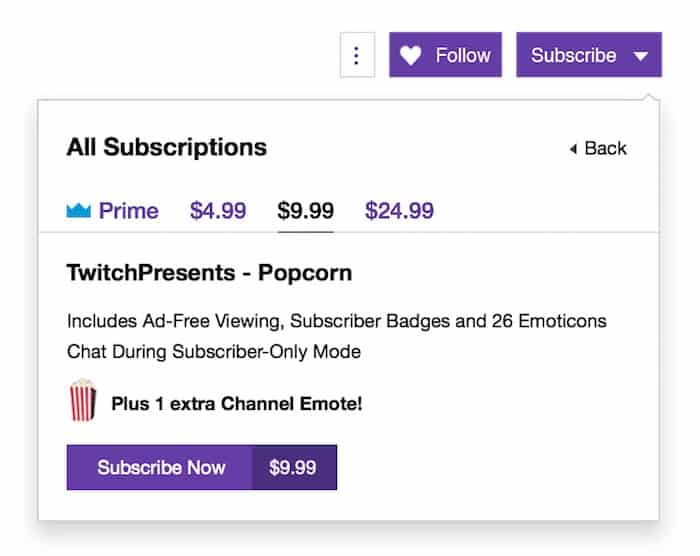
The benefits include access to subscriber-only streams, exclusive chat rooms, custom emoticons, and discounts on merchandise.
2. Twitch Bits
Bits are virtual cheers that viewers purchase and give as a tip during your streams. They can be earned through viewing ads or completing surveys. As an Affiliate, you earn approximately $0.01 per bit donated.
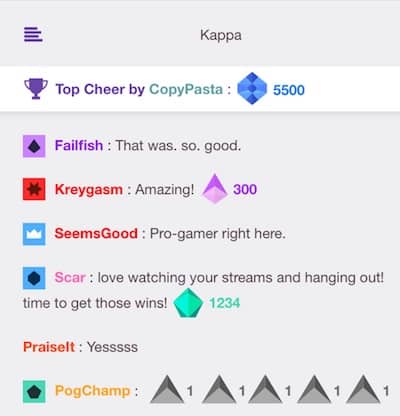
Essentially, Bits are virtual cheers that viewers send to support streamers directly in the chat. As an Affiliate, you earn a small commission—about $0.01—per Bit received.
Increasing Earnings with a Growing Audience
Having a substantial follower base makes earning money easier. Additionally, there are a couple of extra ways to boost your income as your audience expands:1. Brand Sponsorship Opportunities.
You don’t need to be a Twitch Affiliate or Partner to secure sponsorship deals, although having those levels can be advantageous. Twitch allows you to promote various brands and products directly to your viewers.
What’s important is building a sizable and active audience that attracts brands to reach out to you, or alternatively, you can proactively pitch your sponsorship proposals to brands yourself.
2. Selling Your Branded Items.
Once you have cultivated a loyal and engaged fanbase, some viewers might be interested in purchasing your merchandise like phone cases, T-shirts, stickers, mugs, and more. However, establishing a merchandise line takes time and effort. You’ll need to organize manufacturing, printing, and shipping processes, and set up a store using platforms like Shopify with payment integrations.
To simplify things, you can use print-on-demand services such as Printful, which handle manufacturing and shipping for you. When designing your merchandise, you can use tools like Hatchful or Canva, or hire a graphic designer from platforms like Fiverr.
How to Monetize Your Twitch Channel as a Partner.
Once you establish yourself as a successful Twitch Affiliate, you can apply to join the Twitch Partner Program. As a partner, you enjoy all the benefits of being an Affiliate and additional perks like sharing in the revenue generated from ads during your streams.
Pre-roll ads are shown to viewers before your stream starts, and as a partner, you also have the option to initiate mid-roll ads at any point during your broadcast. These ads typically generate between $0.002 and $0.01 per view, providing a steady income stream.
What do I need to start streaming on Twitch?
To begin streaming on Twitch, you first need to create a Twitch account on their website. Next, download and install streaming software compatible with your device. Make a broadcast by selecting your streaming source—this could be a webcam, microphone, or game screen—and ensure all equipment is correctly connected and configured. For detailed instructions, check out the full guide on my blog.
Can I make money by streaming on Twitch?
Absolutely. There are several ways to earn income through Twitch streaming. The most straightforward method is through ad revenue sharing on the platform. Additionally, you can sell merchandise, digital products, or secure brand deals for product placements.
How do I get started with streaming?
Start by creating a Twitch account and downloading streaming software onto your computer or Mac. A basic streaming setup involves capturing your content via a webcam or screen and broadcasting it online. You can begin simply with free tools like Skype or FaceTime for video calls, or opt for more advanced software that supports multiple sources and better control over your stream to enhance quality and flexibility.
Summary of Key Points
Streaming on Twitch is an accessible hobby anyone can try, but turning it into a successful venture requires effort, skill, and strategic planning. Start by setting up your account with the appropriate equipment. As you grow, learn to expand your content through editing skills and community building. Keep an eye on competitors to identify what strategies work best, then adapt and optimize your approach accordingly. The ultimate goal is to grow your audience and monetize your streams effectively.
Top streamers like Ninja, Shroud, and Lirik share common traits—they attract viewers, engage audiences, and earn income through sponsorships, merchandise sales, and other ventures. With perseverance and the right methods, you can achieve similar success and turn your passion into a lucrative career.
